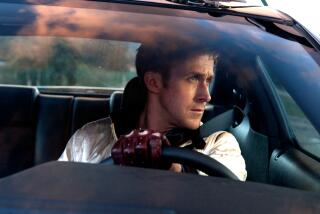TV REVIEWS : ‘All Aboard!’ a Fun, Wonderful Journey
- Share via
As fun as it is informative, “All Aboard! Riding the Rails of American Film” (on cable’s AMC channel tonight at 6 and again at 10) calls attention to the importance of trains in the movies from their very birth. Indeed, as narrator Jason Robards points out, “The Great Train Robbery” (1903), marked the true beginning of the motion picture as an entertainment industry.
With the help of a wonderful, well-researched array of clips and a group of informative interviewees, filmmakers Marcia Ely and Jana DeHart remind us of two great intersecting truths: that, to a very large extent, the history of the United States is the history of its railroads and that, like a train ride, the movies are themselves journeys.
“All Aboard” does a terrific job of differentiating between the kinds of trips that movies with trains have taken us on, starting with the Western, in which the railroad played the major role in the closing of the frontier. The spanning of America from coast to coast by rail has been dramatized in such films as John Ford’s “The Iron Horse” (1924) and Cecil B. DeMille’s “Union Pacific” (1939).
Ely and DeHart suggest, furthermore, that it was the rapaciousness of the railroad tycoons that made it possible for outlaws like Jesse James and Butch Cassidy to become heroes. There’s also a nod to George Sidney’s “The Harvey Girls,” the evergreen 1946 musical honoring the railroad station waitresses and their part in civilizing the West.
“All Aboard!” pays special attention to Alfred Hitchcock, who understood the possibilities of suspense and romance on the rails better than anyone else in such films as “The Lady Vanishes” (1938), “Strangers on a Train” (1951) and “North by Northwest” (1959). The last contains what is almost certainly the most romantic sequence ever filmed aboard a train--Cary Grant’s seduction of Eva Marie Saint; curiously, the filmmakers do not include the sequence’s famously suggestive final shot.
Directors John Frankenheimer and Arthur Hiller tell us about staging the spectacular train crashes in, respectively, “The Train” (1965) and “Silver Streak” (1976), and the part trains play in the coming-of-age genre is represented by “Racing With the Moon” (1984) and “Stand by Me” (1986).
What’s most important for the movies is, above all, the simple fact that trains arrive and depart, providing dramatic, poignant moments of meeting, reunion and especially farewell.
More to Read
The complete guide to home viewing
Get Screen Gab for everything about the TV shows and streaming movies everyone’s talking about.
You may occasionally receive promotional content from the Los Angeles Times.






